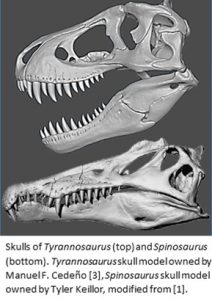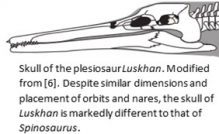By Sean Smart //
 The strange morphology of the dinosaur Spinosaurus has perplexed palaeontologists since its 1912 Egyptian discovery. Its skull features in particular were highly distinct compared to contemporary predatory dinosaurs; Tyrannosaurus possessed a broad robust skull, yet Spinosaurus’ was elongate and narrow [1-3]. Based on this and other features, such as the position of its nostrils (nares), Spinosaurus is thought to have been semi-aquatic, however, any assertions more precise than this regarding ecology and feeding strategies are contentious [1,4,5].
The strange morphology of the dinosaur Spinosaurus has perplexed palaeontologists since its 1912 Egyptian discovery. Its skull features in particular were highly distinct compared to contemporary predatory dinosaurs; Tyrannosaurus possessed a broad robust skull, yet Spinosaurus’ was elongate and narrow [1-3]. Based on this and other features, such as the position of its nostrils (nares), Spinosaurus is thought to have been semi-aquatic, however, any assertions more precise than this regarding ecology and feeding strategies are contentious [1,4,5].
 Building off recent research [6], my supervisor Dr Manabu Sakamoto and I explored whether the skull morphology of Spinosaurus was more similar to other species that exhibited a terrestrial, semi-aquatic or marine (fully aquatic) lifestyle. The species compared were categorised by evolutionary group, to examine the effect of evolutionary history on placement. We explored this by taking skull measurements such as width, height, and length as well as the position of the nares and eye sockets (orbits). I then adjusted data to control for size in 2 different ways to enable more precise analyses and conducted a number of statistical tests, such as a multivariate analysis of variance (MANOVA), principal component analysis (PCA) and cluster analyses.
Building off recent research [6], my supervisor Dr Manabu Sakamoto and I explored whether the skull morphology of Spinosaurus was more similar to other species that exhibited a terrestrial, semi-aquatic or marine (fully aquatic) lifestyle. The species compared were categorised by evolutionary group, to examine the effect of evolutionary history on placement. We explored this by taking skull measurements such as width, height, and length as well as the position of the nares and eye sockets (orbits). I then adjusted data to control for size in 2 different ways to enable more precise analyses and conducted a number of statistical tests, such as a multivariate analysis of variance (MANOVA), principal component analysis (PCA) and cluster analyses.
Our results showed that there was a large amount of crossover between groups and ecologies. Spinosaurus’ morphology fell within the morphospace occupied by terrestrial theropods (bipedal carnivorous dinosaurs like Tyrannosaurus), but also being extremely close to marine plesiosaurs, with its closest match being the plesiosaur Luskhan [7]. This suggests that the measurements we used were not suitable to diagnose ecology [8]. Similarly, our cluster analyses recovered patterns that reflected body size of taxa as opposed to their ecology.
 Having the initial hypothesis disproven enabled us to change the direction of our conclusion away from inferences from our data, towards the data itself, and the failure to recover ecological information. Furthermore, as this project required images of skulls in both lateral and dorsal view, very fragmentary fossils couldn’t be used, limiting how many group representatives could be included. To account for this we used distantly related members within groups where possible.
Having the initial hypothesis disproven enabled us to change the direction of our conclusion away from inferences from our data, towards the data itself, and the failure to recover ecological information. Furthermore, as this project required images of skulls in both lateral and dorsal view, very fragmentary fossils couldn’t be used, limiting how many group representatives could be included. To account for this we used distantly related members within groups where possible.
Dr Sakamoto has been indispensable to this research; without his assistance and expertise I wouldn’t have been able to utilise so many informative and at times complex statistical methods. I often looked forward to passing ideas back and forth at our meetings as we interpreted the data. Beyond those research skills I have developed, this project has improved my ability to divide and compartmentalise research tasks to ensure a consistent pace of work. Through this, I feel I have improved my ability to disseminate research to a lay-audience.
*To view Sean’s research poster and presentation recording, please click on the thumbnails below:
References:
[1] Ibrahim, N., Sereno, P.C., Dal Sasso, C., Maganuco, S., Fabbri, M., Martill, D.M., Zouhri, S., Myhrvold, N. and Iurino, D.A., 2014. Semiaquatic adaptations in a giant predatory dinosaur. Science, 345(6204), pp.1613-1616.
[2] Meers, M.B., 2002. Maximum bite force and prey size of Tyrannosaurus rex and their relationships to the inference of feeding behavior. Historical Biology, 16(1), pp.1-12.
[3] Cedeño, M.F., 2021. Tyrannosaurus Rex Skull Bones Sculpture. Artstation.com, Cedeño, M.F. Available from: https://www.artstation.com/artwork/5XVKmw
[4] Ibrahim, N., Maganuco, S., Dal Sasso, C., Fabbri, M., Auditore, M., Bindellini, G., Martill, D.M., Zouhri, S., Mattarelli, D.A., Unwin, D.M. and Wiemann, J., 2020. Tail-propelled aquatic locomotion in a theropod dinosaur. Nature, 581(7806), pp.67-70.
[5] Henderson DM. A buoyancy, balance and stability challenge to the hypothesis of a semi-aquatic Spinosaurus Stromer, 1915 (Dinosauria: Theropoda). PeerJ. 2018 Aug 16;6:e5409.
[6] Hone, D.W. and Holtz Jr, T.R., 2021. Evaluating the ecology of Spinosaurus: Shoreline generalist or aquatic pursuit specialist?. Palaeontologia Electronica, 24(1), p.a03.
[7] Fischer, V., Benson, R.B., Zverkov, N.G., Soul, L.C., Arkhangelsky, M.S., Lambert, O., Stenshin, I.M., Uspensky, G.N. and Druckenmiller, P.S., 2017. Plasticity and convergence in the evolution of short-necked plesiosaurs. Current Biology, 27(11), pp.1667-1676.
[8] Coleman, M.N., 2008. What does geometric mean, mean geometrically? Assessing the utility of geometric mean and other size variables in studies of skull allometry. American Journal of Physical Anthropology: The Official Publication of the American Association of Physical Anthropologists, 135(4), pp.404-415.
